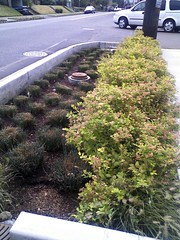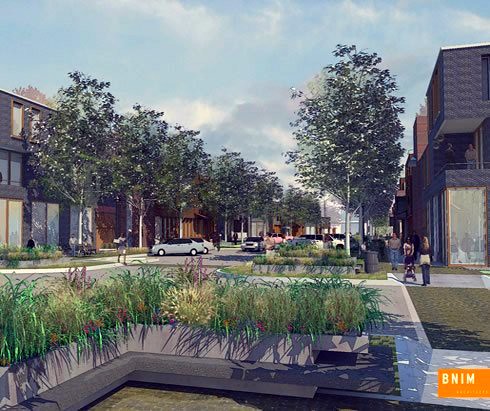How green infrastructure is making cities more sustainable & hospitable

Posted October 11, 2011 at 1:31PM
The American Society of Landscape Architects has just released a massive database of 479 case studies describing the successful application of ”green infrastructure” techniques that collect and process rainwater naturally before it flows into receiving waterways as polluted runoff. The database demonstrates the power of increasingly widespread application of sustainable practices to prevent pollution while simultaneously bringing nature and natural process back into urban environments. The case studies come from 43 states, the District of Columbia, and Canada.
This promises to be a great resource: One of the most pressing environmental challenges facing cities and suburbs in the US is the impact of polluted stormwater runoff from developed land – highways, parking lots, rooftops and other impermeable surfaces – into our rivers, lakes, and coastal waters. The federal EPA estimates that more than 10 trillion gallons of untreated urban and suburban stormwater runoff makes its way into our surface waters each year, degrading recreation, destroying fish habitat, and altering stream ecology and hydrology.
The problem becomes particularly acute in cities that drain both stormwater and sewage into a common set of pipes and conveyances. When major storm events prove more than these frequently older systems can handle, the result is “combined sewer overflows,” a noxious mess.
 With the use of green infrastructure (also known as low impact development). a set of urban design techniques replicate the way nature deals with rainwater – using vegetation and soils as natural sponges for runoff – rather than relying exclusively on the concrete pipes and holding tanks of the past.
With the use of green infrastructure (also known as low impact development). a set of urban design techniques replicate the way nature deals with rainwater – using vegetation and soils as natural sponges for runoff – rather than relying exclusively on the concrete pipes and holding tanks of the past.
Such techniques as green roofs, roadside plantings, rain gardens, permeable paving, and rainwater harvesting not only improve water quality; they also transform rainwater from a source of pollution into a valuable community resource. Done well, low impact development helps to literally green the urban landscape, cool and cleanse the air, reduce asthma and heat-related illnesses, cut heating and cooling energy costs, create urban oases of open space, and generate green landscaping and construction jobs.
As I have written before, smart growth – growing our metropolitan regions in more compact patterns – helps reduce the volume of runoff across watersheds, because it reduces the spread of new pavement into previously undeveloped or minimally developed areas. But it is not enough, because we need waterways near our existing developed areas to become cleaner and safer. Many cities and suburbs are now undergoing more intensive development, as they must to address other environmental concerns such as transportation efficiency and land conservation. But, if the development does not proceed in a manner that accounts for the potential of runoff, some waterways could become even more polluted.
It is particularly encouraging that half of the case studies analyzed by ASLA were retrofits of existing development. Another 19 percent involved redevelopment projects. The organization also found that the use of green infrastructure reduced development costs more frequently than it added them, probably because successful green infrastructure can obviate some of the concrete “gray infrastructure” otherwise required to drain runoff. 75 percent said that the use of green infrastructure either lowered or did not influence costs.
 Bioswales were the most common forms employed, with rain gardens, bioretention, and porous pavers close behind. 40 percent of the projects required the management of an acre or less of land; 75% required the management of five acres or less. 68 percent of the projects were assisted with public funds. (NRDC and American Rivers assisted ASLA in this project.)
Bioswales were the most common forms employed, with rain gardens, bioretention, and porous pavers close behind. 40 percent of the projects required the management of an acre or less of land; 75% required the management of five acres or less. 68 percent of the projects were assisted with public funds. (NRDC and American Rivers assisted ASLA in this project.)
By coincidence, I have reported on a few of the identified case studies, including the Tempe (AZ) Transportation Center; Tassafaronga Housing, in Oakland; High Point HOPE VI Redevelopment, Seattle; and The Brewery, Milwaukee. But they actually missed some truly exemplary projects including, for example, Seattle's "Green Factor" Program; Dockside Green, in Victoria, BC; the Greensburg (KS) Sustainable Comprehensive Plan; Thornton Creek, in Seattle; and the Vancouver (BC) Olympic Village (now Millennium Water). As impressively sizable as it is, the database could actually be larger.
Perhaps the country’s leading example of the planned adoption of green infrastructure at a significant scale is the city of Philadelphia. Under a formal plan to meet Clean Water Act requirements, approved by the federal EPA Pennsylvania environmental regulators in June of this year, the city has now agreed to transform at least one-third of the impervious areas served by its sewer system into “greened acres” -- spaces that use green infrastructure to infiltrate, or otherwise collect, the first inch of runoff from any storm. My colleague Larry Levine, who has been working with the city, says that amounts to keeping 80-90% of annual rainfall from these areas out of the Philadelphia’s over-burdened sewer system.
I love green infrastructure, because we clearly need urban density in order to even approach solving problems related to land conservation and transportation patterns and emissions. But these techniques – in many cases literally as well as figuratively green – have the effect of softening that density, making it more appealing as well as better functioning.
Move your cursor over the images for credit information.
